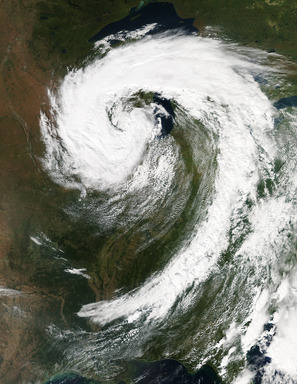7 Extreme Weather
THUNDERSTORMS
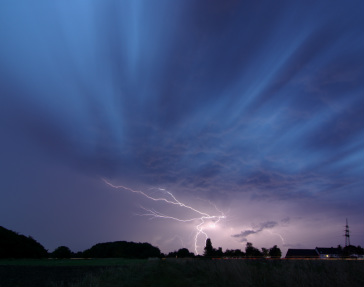
Weather happens every day, but only some days have storms. Storms vary immensely depending on whether they’re warm or cold, coming off the ocean or off a continent, occurring in summer or winter, and many other factors. The effects of storms also vary depending on whether they strike a populated area or a natural landscape. Hurricane Katrina is a good example, since the flooding after the storm severely damaged New Orleans, while a similar storm in an unpopulated area would have done little damage. Thunderstorms are extremely common: Worldwide there are 14 million per year; that’s 40,000 per day! Most drop a lot of rain on a small area quickly, but some are severe and highly damaging. They form when ground temperatures are high, ordinarily in the late afternoon or early evening in spring and summer.
WHERE DO THEY HAPPEN
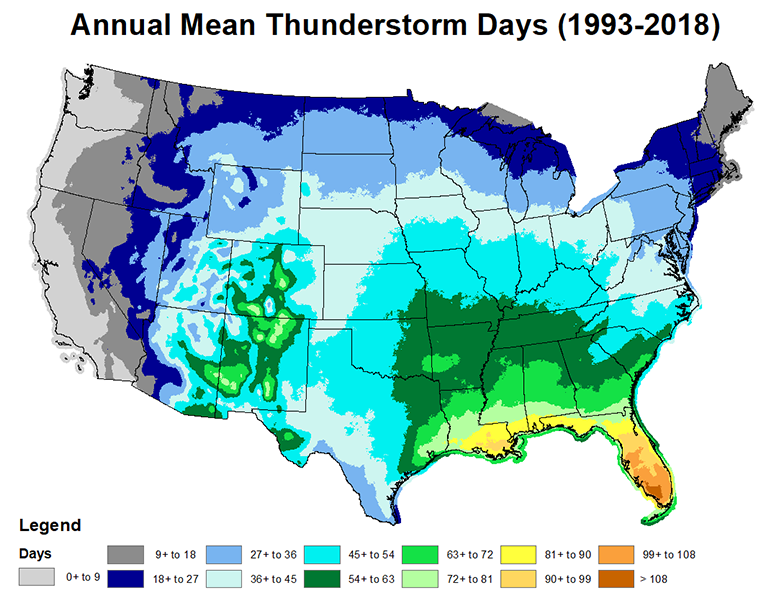
THUNDERSTORM GENESIS
All thunderstorms go through a three-stage life cycle. The first stage is called the cumulus stage, where an air parcel is forced to rise, cool, and condense and develop into a cumulus cloud. Water vapor condenses at the altitude called the Lifting Condensation Level. The exact altitude for condensation varies depending on temperature and humidity (relative humidity) of the rising air parcel. The process of water vapor condensing into liquid water releases large quantities of latent heat, which makes the air within the cloud warmer, and unstable. The instability causes the cloud to continue to grow upward like a hot air balloon. These rising air parcels, called updrafts, prevent small water droplets from falling from the cloud. But once the water droplets become too large heavy for the updrafts to hold up, the moisture begins to fall as precipitation and downdrafts happen within the cloud. The downdrafts also begin to pull cold, dry air from outside the cloud toward the ground in a process called entrainment. Once the precipitation begins to fall from the cloud, the storm has reached the mature stage. During this stage, updrafts and downdrafts exist side-by-side and the cumulonimbus is called a cell. If the updrafts reach the top of the troposphere, the cumulus cloud will begin to spread outward creating a defined anvil. At the same time, the downdrafts spread within the cloud and at first make the cloud become wider, but eventually overtaking the updrafts. Cool downdrafts form when precipitation and the cool air from entrainment are dragged down to the lower regions of a thunderstorm. It is also during the mature stage when the storm is most intense producing strong, gusting winds, heavy precipitation, lightning, and possibly small hail.
Once the downdrafts overtake the updrafts, which also prevents the release of latent heat energy, the thunderstorm will begin to weaken into the third and final stage, called the dissipating stage. During this stage, light precipitation and downdrafts become the dominate feature within the cloud as it weakens. In all, only twenty percent of the moisture within the cloud fell as precipitation whereas the other eighty percent evaporates back into the atmosphere. The two figures below show two stages of thunderstorm buildup.

With severe thunderstorms, the downdrafts are so intense that when they hit the ground it sends warm air from the ground upward into the storm. The warm air gives the convection cells more energy. Rain and hail grow huge before gravity pulls them to Earth. Severe thunderstorms can last for hours and can cause a lot of damage because of high winds, flooding, intense hail, and tornadoes.
Thunderstorms can form individually or in squall lines along a cold front. In the United States, squall lines form in spring and early summer in the Midwest where the maritime tropical (mT) air mass from the Gulf of Mexico meets the continental polar (cP) air mass from Canada.
So much energy collects in cumulonimbus clouds that a huge release of electricity, called lightning, may result. The electrical discharge may be between one part of the cloud and another, two clouds, or a cloud and the ground.
Lightning heats the air so that it expands explosively. The loud clap is thunder. Light waves travel so rapidly that lightning is seen instantly. Sound waves travel much more slowly, so a thunderclap may come many seconds after the lightning is spotted. Thunderstorms kill approximately 200 people in the United States and injure about 550 Americans per year, mostly from lightning strikes. Have you heard the common misconception that lightning doesn’t strike the same place twice? In fact, lightning strikes the New York City’s Empire State Building about 100 times per year.
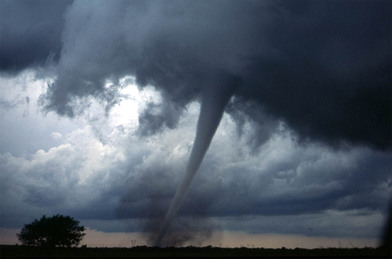
Tornadoes, also called twisters, are fierce products of severe thunderstorms. As air in a thunderstorm rises, the surrounding air races in to fill the gap, forming a funnel. A tornado lasts from a few seconds to several hours. The average wind speed is about 177 kph (110 mph), but some winds are much faster. A tornado travels over the ground at about 45 km per hour (28 miles per hour) and goes about 25 km (16 miles) before losing energy and disappearing.
An individual tornado strikes a small area, but it can destroy everything in its path. Most injuries and deaths from tornadoes are caused by flying debris. In the United States an average of 90 people are killed by tornadoes each year. The most violent two percent of tornadoes account for 70% of the deaths by tornadoes. Tornadoes form at the front of severe thunderstorms. Lines of these thunderstorms form in the spring where where maritime tropical (mT) and continental polar (cP) air masses meet. Although there is an average of 770 tornadoes annually, the number of tornadoes each year varies greatly.
|
|
|
In late April 2011, the situation was ripe for the deadliest set of tornadoes in 25 years. In addition to the meeting of cP and mT mentioned above, the jet stream was blowing strongly in from the west. The result was more than 150 tornadoes reported throughout the day. The entire region was alerted to the possibility of tornadoes in those late April days. But meteorologists can only predict tornado danger over a very wide region. No one can tell exactly where and when a tornado will touch down. Once a tornado is sighted on radar, its path is predicted and a warning is issued to people in that area. The exact path is unknown because tornado movement is not very predictable.
Since 2007, the intensity of tornadoes is assigned with the Enhanced Fujita Scale, which assigns a value based on both wind speed and damage. Prior to 2007, the Fujita scale used only wind speed. However humans aren’t necessarily interested in wind speed, we want to know what the impact of the wind will be. So the Enhanced Fujita Scale includes building damage.
|
EF-Scale EF0 (Gale) EF1 (Weak) EF2 (Strong) EF3 (Severe) EF4 (Devastating) EF5 (Incredible) |
3 Second Gust (mph) 65-85 86-110 111-135 136-165 166-200 Over 200 |
Damage Light – tree branches fall and chimneys may collapse Moderate – mobile homes, automobiles pushed aside Considerate – roofs torn off houses, large trees uprooted Severe – houses torn apart, trees uprooted, cars lifted Devastating – houses leveled, cars thrown Incredible – structures fly, cars become missiles |

Cyclones can be the most intense storms on Earth. A cyclone is a system of winds rotating counterclockwise in the Northern Hemisphere around a low pressure center. In the Southern Hemisphere a cyclone rotates clockwise. The swirling air rises and cools, creating clouds and precipitation.
There are two types of cyclones: middle latitude (mid-latitude) cyclones and tropical cyclones. Mid-latitude cyclones are the main cause of winter storms in the middle latitudes. Tropical cyclones are also known as hurricanes.
An anticyclone is the opposite of a cyclone. An anticyclone’s winds rotate clockwise in the Northern Hemisphere around a center of high pressure. Air comes in from above and sinks to the ground. High pressure centers generally have clear skies.
MID-LATITUDE CYCLONES
Mid-latitude cyclones, sometimes called extratropical cyclones, form at the polar front when the temperature difference between two air masses is large. These air masses blow past each other in opposite directions. Coriolis Effect deflects winds to the right in the Northern Hemisphere, causing the winds to strike the polar front at an angle. Warm and cold fronts form next to each other. Most winter storms in the middle latitudes, including most of the United States and Europe, are caused by mid-latitude cyclones. The warm air at the cold front rises and creates a low pressure cell. Winds rush into the low pressure and create a rising column of air. Since the rising air is moist, rain or snow falls. Mid-latitude cyclones form in winter in the mid-latitudes and move eastward with the westerly winds. These two- to five-day storms can reach 1,000 to 2,500 km (625 to 1,600 miles) in diameter and produce winds up to 125 km (75 miles) per hour. Like tropical cyclones, they can cause extensive beach erosion and flooding. Mid-latitude cyclones are especially fierce in the mid-Atlantic and New England states where they are called nor’easters, because they come from the northeast. About 30 nor’easters strike the region each year.
TROPICAL CYCLONES: HURRICANES
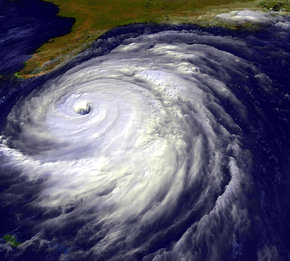
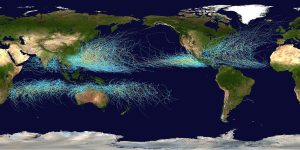
Tropical cyclones have many names. They are called hurricanes in the North Atlantic and eastern Pacific oceans, typhoons in the western Pacific Ocean, tropical cyclones in the Indian Ocean, and willi-willi’s in the waters near Australia. By any name, they are the most damaging storms on Earth. Hurricanes arise in the tropical latitudes (between 10° and 25 ° N) in summer and autumn when sea surface temperature are 28°C (82°F) or higher. The warm seas create a large humid air mass. The warm air rises and forms a low pressure cell, known as a tropical depression. Thunderstorms materialize around the tropical depression. If the temperature reaches or exceeds 28° C (82° F) the air begins to rotate around the low pressure. As the air rises, water vapor condenses, releasing energy from latent heat. If wind shear (upper atmosphere winds) is low, the storm builds into a hurricane within two to three days. Hurricanes are huge with high winds. The exception is the relatively calm eye of the storm where air is rising upward. Rainfall can be as high as 2.5 cm (1″) per hour, resulting in about 20 billion metric tons of water released daily in a hurricane. The release of latent heat generates enormous amounts of energy, nearly the total annual electrical power consumption of the United States from one storm. Hurricanes can also generate tornadoes.
|
|
|
Hurricanes are strange creatures because they are deadly monsters, yet have a gentle, but cold heart. The anatomy of a hurricane is fairly simple, though the processes involved are quite complex. As a low pressure disturbance forms, the warm, moist air rushes towards the low pressure in order to rise upward to form towering thunderstorms. Around the low pressure disturbance is a wall of clouds called an eye wall. Within the eye wall, the wind speeds are greatest, the clouds are the tallest, atmospheric pressure is at its lowest, and precipitation is most intense.
At the center or heart of the hurricane is called the eye. Within the eye of a hurricane, winds are light, precipitation is minimal, and occasionally the skies above are clear. It is the calm region of the tropical storm, but that is what makes it so dangerous. Many people tend to go outside as the eye moves overhead because they believe the storm is over. But what some don’t realize is that “round two” is coming from behind.
Moving away from the eye wall are organized, intense thunderstorms, called spiral rain bands, that rotate around and toward the storm’s eye wall. These rain bands are the first
Hurricanes are assigned to categories based on their wind speed. The categories are listed on the Saffir-Simpson Scale.
|
Category 1 (Weak) 2 (Moderate) 3 (Strong) 4 (Very strong) 5 (Devastating) |
MPH 74-95 96-110 111-130 131-156 Over 156 |
Estimated Damage Above normal; no read damage to structures Some property damage; considerable damage to vegetation Some buildings damaged; mobile homes destroyed Complete roof failure on small residences; major beach erosion of beach areas Complete roof and some building failure on most residential and industrial buildings |
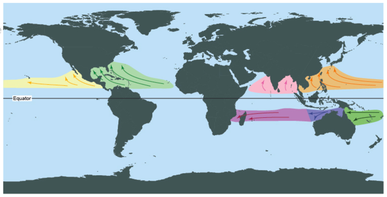
Hurricanes move with the prevailing winds. In the Northern Hemisphere, they originate in the trade winds and move to the west. When they reach the latitude of the westerlies, they switch direction and travel toward the north or northeast. Hurricanes may cover 800 km (500 miles) in one day. Damage from hurricanes comes from the high winds, rainfall, and storm surge. Storm surge occurs as the storm’s low pressure center comes onto land, causing the sea level to rise unusually high. A storm surge is often made worse by the hurricane’s high winds blowing seawater across the ocean onto the shoreline. Flooding can be devastating, especially along low-lying coastlines such as the Atlantic and Gulf Coasts. Hurricane Camille in 1969 had a 7.3 m (24 foot) storm surge that traveled 125 miles (200 km) inland. Hurricanes typically last for 5 to 10 days. Over cooler water or land, the hurricane’s latent heat source shut downs and the storm weakens. When a hurricane disintegrates, it is replaced with intense rains and tornadoes.
There are about 100 hurricanes around the world each year, plus many smaller tropical storms and tropical depressions. As people develop coastal regions, property damage from storms continues to rise. However, scientists are becoming better at predicting the paths of these storms and fatalities are decreasing. There is, however, one major exception to the previous statement: Hurricane Katrina.
For over a decade, the conversation in the United States over hurricanes was directed toward Hurricane Katrina. But in late October 2012, a Category 3 hurricane called Hurricane Sandy, sometimes called Superstorm Sandy, struck the eastern coast of the United States. It is estimated that the storm system caused $68 billion in damage and killed nearly 300 people.
What made Hurricane Sandy different from most tropical storms was how powerful it was so late in the hurricane season. The concern is that as the planet warms from anthropogenic (human-enhanced) climate change, the oceans will likely warm up allow hurricanes to become stronger, travel farther toward the poles, and the hurricane season last longer.
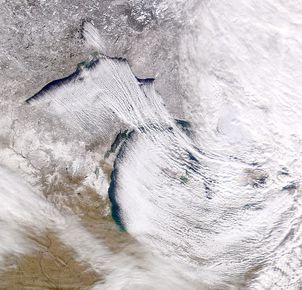
A blizzard is distinguished by certain conditions:
- Temperatures below –7°C (20° F); –12°C (10° F) for a severe blizzard.
- Winds greater than 56 kmh (35 mph); 72 kmh (45 mph) for a severe blizzard.
- Snow so heavy that visibility is 2/5 km (1/4 mile) or less for at least three hours; near zero visibility for a severe blizzard.
Blizzards happen across the middle latitudes and toward the poles, usually as part of a mid-latitude cyclone. Blizzards are most common in winter, when the jet stream has traveled south and a cold, northern air mass comes into contact with a warmer, semitropical air mass. The very strong winds develop because of the pressure gradient between the low pressure storm and the higher pressure west of the storm. Snow produced by the storm gets caught in the winds and blows nearly horizontally. Blizzards can also produce sleet or freezing rain.
In winter, a continental polar air mass travels down from Canada. As the frigid air travels across one of the Great Lakes, it warms and absorbs moisture. When the air mass reaches the leeward side of the lake, it is very unstable and it drops tremendous amounts of snow. This lake-effect snow falls on the snowiest, metropolitan areas in the United States: Buffalo and Rochester, New York.
HEAT WAVES
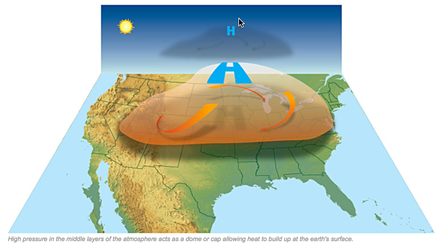
Even more insidious are the deadliest weather phenomena, a heat wave. A heat wave is different for different locations; it is a long period of hot weather, at least 86° F (30° C) for at least three days in cooler locations but much more in hotter locations. Heat waves have increased in frequency and duration in recent years. In the image to the right, a high pressure zone kept the jet stream further north than normal for August which allow hot air to shift far north.


